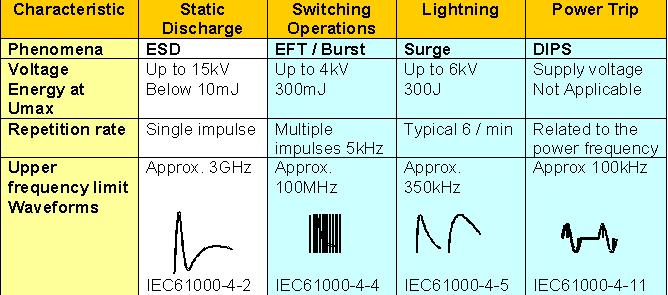The IEC 61000-4-X series of standards are primarily, but not exclusively, concerned with immunity test methods. The number of parts either published or in draft form is now approaching 40, but the majority of these concern phenomena or techniques which are not relevant to most products presently being tested.
The parts listed below are those which are referenced most broadly in the product and generic standards.
|
Number |
Title |
Description |
|
Electromagnetic compatibility (EMC) – Part 4-x: Testing and measurement techniques |
||
|
IEC 61000-4-2 |
Electrostatic discharge immunity test |
Simulates the threat from a local or direct discharge from a charged person; two direct discharge methods (air and contact) plus indirect |
|
IEC 61000-4-3 |
Radiated, radio-frequency, electromagnetic field immunity test |
Represents the threat from radio transmitters in the vicinity of the apparatus; severity levels represent three grades of environment, depending mostly on the likelihood of portable or high power fixed transmitters being nearby. Test applies above 80MHz |
|
IEC 61000-4-4 |
Electrical fast transient/burst immunity test |
Subjects the EUT to bursts of transients that test immunity to disturbances caused mainly by local power switching operations. The name “fast” distinguishes them from lower-frequency surges caused by distant disturbances |
|
IEC 61000-4-5 |
Surge immunity test |
Applies high energy but relatively low bandwidth transients, particularly representing nearby lightning strikes. The unipolar surge combines different voltage and current waveforms and it is therefore known as the “combination wave” |
|
IEC 61000-4-6 |
Immunity to conducted disturbances, induced by radio-frequency fields |
Complementary to IEC 61000-4-3. Interference at lower frequencies is generally coupled through connected cables; this test applies up to 80MHz |
|
IEC 61000-4-8 |
Power frequency magnetic field immunity test |
Immerses the EUT in a constant 50Hz magnetic field, representing interference from e.g. power transformers |
|
IEC 61000-4-11 |
Voltage dips, short interruptions and voltage variations immunity tests |
Disturbances of the supply voltage itself (sometimes known as Power Quality); the standard test specifies particular levels and periods of dips and interruptions on the mains supply |
The typical content of each of these documents follows the same pattern:
- Scope
- Test disturbance levels to be applied
- Instructions for test: equipment, method, layout
- Performance criteria: usually four options
These standards also define the construction (in some cases) and calibration of the test disturbance generators and facilities. Although the amplitudes of the applied disturbance levels are defined, they are normally given as a variety of levels for different application environments. This means that they are not suitable on their own as harmonized standards for compliance purposes, and it would be wrong to declare compliance only to these documents, without stating applied levels and performance criteria.
A major difference with respect to emissions standards is in the definition of the criteria for pass or fail. For emissions it is relatively straightforward to compare a result to a limit and if necessary apply the 80/80 rule. For immunity, checking compliance is far from straightforward since the actual response of an EUT to a disturbance must be compared against its expected operation. Performance criteria are an important area, but are inherently product-specific and can only be generally defined in the test method standards. Individual product standards should lay down more detailed performance criteria than is possible in the generic standards.
The options offered in the IEC 61000-4 series are:
- normal performance within the specification limits;
- temporary degradation or loss of function or performance which is self-recoverable;
- temporary degradation or loss of function or performance which requires operator intervention or system reset;
- degradation or loss of function which is not recoverable due to damage of equipment (components) or software, or loss of data.
These are simply different classifications of response, and don’t of themselves imply pass or fail, although clearly some are more acceptable than others.
Applicability
The application of each of these basic tests is defined in product or generic standards which apply to a particular class of product. You need to review and interpret these standards’ requirements for each EUT. Some general observations can be made:
- The power frequency magnetic field test (IEC 61000-4-8) is normally only applied to products which are likely to be affected by such fields, such as monitors using cathode ray tubes, or devices with magnetic sensors.
- The surge test is applied to long lines, particularly those which can extend outside a building such as LAN and telecom lines and power supplies.
- EFT/B and conducted RF tests tend not to be applied to short cable ports, typically shorter than 3m, on the grounds that such short lines won’t pick up significant disturbances.
- The ESD test is only applied to those parts of the EUT which are accessible to personnel in normal operation.
- The radiated RF immunity test is almost universal, and all conducted tests will normally be applied to mains power ports.



